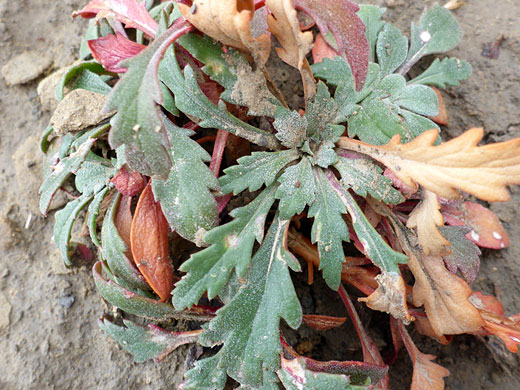
Tubular, pink, five-lobed flowers of aliciella haydenii, Knife Edge Trail, Mesa Verde National Park, Colorado
Common name:
Hayden's gilia
Family:
Scientific name:
Aliciella haydenii
Synonyms:
Gilia haydenii, gilia montezumae
Main flower color:
Range:
The Four Corners area
Height:
Up to 20 inches
Habitat:
Barren slopes, open woodland
Leaves:
Oblanceolate, lobed, glandular hairy, mostly basal; up to 3 inches long
Season:
May to September
The thin stems of aliciella haydenii branch freely, and usually have a sparse covering of short, branched, glandular hairs. Leaves are mostly basal, arranged in a dense rosette, but are also found along the stems, where they are reduced in size. Basal leaves are lined with large, well-separated teeth, or lobes; upper stem leaves are generally unlobed.
Flowers form singly or in clusters of up to five, at the tips of the branches. They are formed of a short calyx, less than a quarter of an inch in length, divided into five pointed lobes which have reddish midveins and pale green margins, and a narrow, tubular, pink corolla, two or three times as long, opening to five, spreading, oblanceolate lobes, often somewhat paler in color. Five pale blue stamens are attached to the middle of the base of the lobes, and are about the same height as the corolla tubes.
There are two subspecies of aliciella haydenii; ssp haydenii and the less common ssp crandallii, which has corolla tubes that are longer, and become wider towards the tip.
Flowers form singly or in clusters of up to five, at the tips of the branches. They are formed of a short calyx, less than a quarter of an inch in length, divided into five pointed lobes which have reddish midveins and pale green margins, and a narrow, tubular, pink corolla, two or three times as long, opening to five, spreading, oblanceolate lobes, often somewhat paler in color. Five pale blue stamens are attached to the middle of the base of the lobes, and are about the same height as the corolla tubes.
There are two subspecies of aliciella haydenii; ssp haydenii and the less common ssp crandallii, which has corolla tubes that are longer, and become wider towards the tip.
All Contents © Copyright The American Southwest | Comments and Questions | Contribute | Site Map



